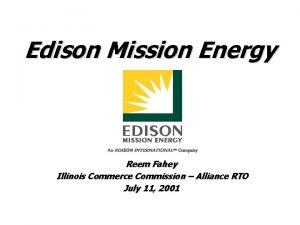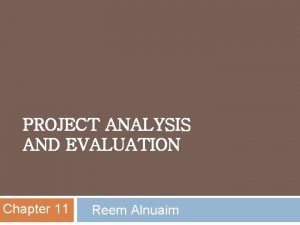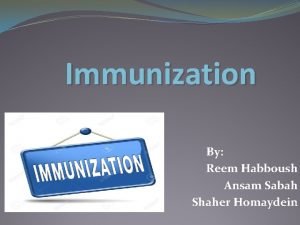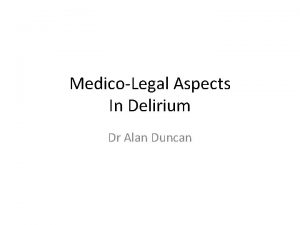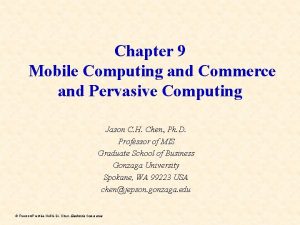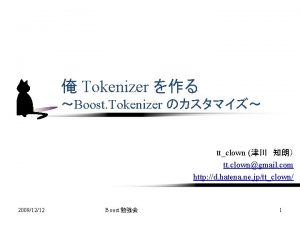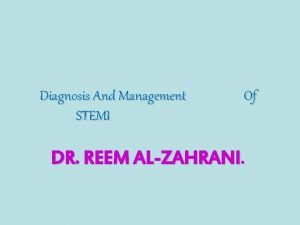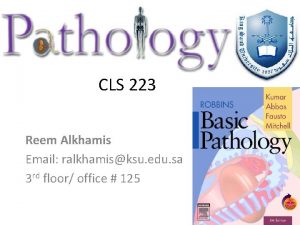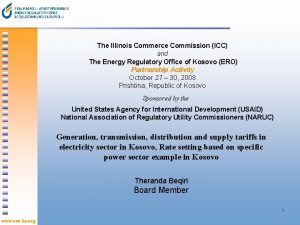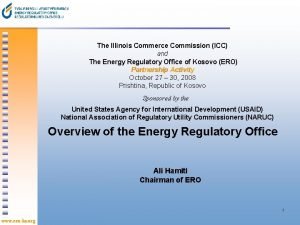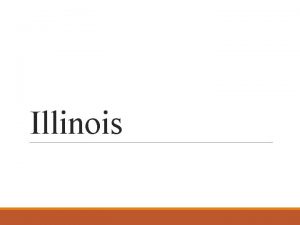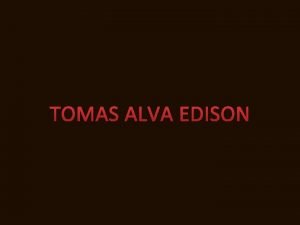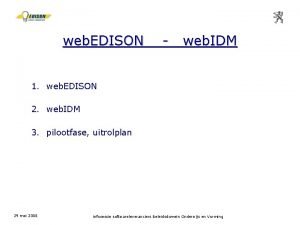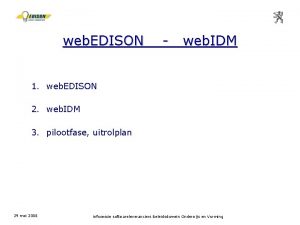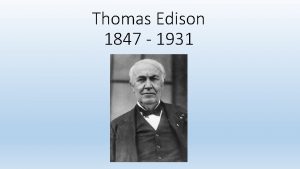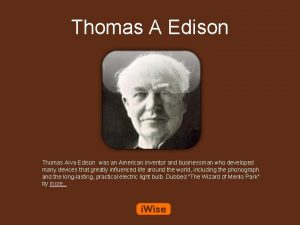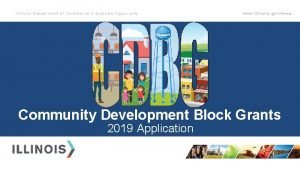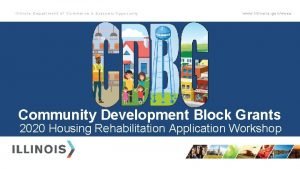Edison Mission Energy Reem Fahey Illinois Commerce Commission















- Slides: 15

Edison Mission Energy Reem Fahey Illinois Commerce Commission – Alliance RTO July 11, 2001

Midwest ISO/Alliance RTO Settlement • On May 8 th, 2001 FERC approved the settlement agreement • The settlement agreement will allow the two competing organizations to remain separate entities with unified “super-regional” rate designed to resolve all seams issues and remove pancake rates between the two organizations • In exchange for the right to leave, the three Illinois companies agreed to pay MISO $60 Million in start-up cost 2

Alliance

Midwest ISO/Alliance RTO Settlement • Agreement to develop procedures and protocols to ensure compatibility across the region in the following areas: – – – – 4 Real-time balancing market (May 31, 2001) Generation Interconnection Agreement (June 30, 2001) Day one and Long Term Congestion Management (December 31, 2001) One-stop shopping Coordinated Planning Cooperation in Security Coordination Independent Market Monitoring Compatible business practices (October 15, 2001)

Divergence in Energy Imbalance Market Design • In spite of the commitment per the settlement agreement to design a compatible and seamless energy imbalance market within the combined Alliance/Midwest ISO footprint, the proposals are fundamentally different as follows: Design Aspect Alliance Midwest ISO Overall Approach Imbalance engine directs generators to inc/dec on a 15 minute basis Allows entities to self-balance using Congestion Management prices for discovery of sources of incs/decs Settlement Interval 15 minutes One hour Regional Participation Regional participation allowed (within Alliance) No (balkanized per control area) Penalties 5 No penalties 15% penalty charge applicable to imbalance outside deadband

Interconnection Procedures & Agreement Potential Non-Compliance • The Settlement Agreement requires one common Generation Interconnection Agreement by June 30, 2001 • Progress to date indicates that MISO and Alliance each has its own procedure and agreement. The major differences are as follows: – The parties involved in the agreement – Treatment of generation interconnection at distribution voltage – Transmission Credits 6

Potential Incompatibility in Long-Term Congestion Management • The Midwest ISO Advisory Committee directed their staff to propose to Alliance the formation of a “Joint MISO/Alliance Congestion Management Forum” to comply with the directive of the settlement agreement to create a seamless market • Proposal rejected by Alliance • As a result, Alliance and MISO each has a congestion management/market design committee that meet separately yet both are discussing and debating the same issues • This could potentially result in congestion management systems that are incompatible • Recommendation : The Alliance/Midwest ISO market needs to be designed as one thru a unified effort, and not by independently designing two markets and then piecing them together 7

ARTO Congestion Management Hybrid Model ARTO Day 2 Congestion Management Approach WORK IN PROGRESS Day 2 4 Operational by 12/02 4 Forward market for transmission rights 4 LMP for real-time congestion management 8

ARTO Congestion Management Forward Market - Flowgates o Forward market for transmission rights based on Flowgates o Flowgates - transmission elements that have the potential to have congestion that exceeds a designated threshold o Designated by ARTO o Intent is to identify all Flowgates with commercial significance - Commercially Significant Flowgates (CSFs) o Value of flowgate transmission rights associated with CSFs determined by market o May result in multiple hundreds of Flowgates within ARTO o Designated a year in advance 9

ARTO Congestion Management Concerns Regarding the Flowgate Model o No industry experience o Premised on two false concepts: o Congestion is easily predictable in the forward market o Consequences : o Uplift of congestion cost when RTO “misses” a commercially significant Flowgate o Otherwise; Unmanageable number of Flowgates (multiple hundreds range) o Distribution factors of transactions on Flowgates are stable o Consequences : o Uplift (if RTO guarantees against changes in distribution factors) o Imperfect Hedges (if RTO directly assigns) 10

Alliance RTO Key Issues o FGR Distribution Method (Auction vs. Allocation) o Long-term FGRs (5 years, 10 years) o Equivalent of “firm” transmission in the future o Balanced day-ahead schedules will be required. . no provision for self -scheduling o Extensive number of flowgates o Inter-RTO congestion management approach(es) o Retention of multiple control areas 11

Congestion Management Recommendations o Regulators (FERC and State Commissioners) should insist on a Standard Market Design Model (PJM’s LMP model) o Regulators should resist accepting “Innovative Market Design” proposals. . . consequences of a flawed model are too grave o If RTOs file for “Innovative Market Design” proposals, Regulators should put the burden of proof on the RTOs: o How is the proposal superior to the Standard Market Design model? o If superior, how will the proposal comply with Order 2000 “Function 8” (seamless trading between adjacent RTOs) ? 12

Alliance Stakeholder Process • As far as the Alliance stakeholder process, EME fully agrees with the State Commissioners assessment as described in their June 18 th filing, as follows: – “There is no managing member, no interim independent entity to facilitate the transition, no formal stakeholder process and no concrete plan for meeting the upcoming tariff filing milestones” – “Instead of taking steps to formalize and implement a Stakeholder Advisory Committee, the Alliance Companies have implemented a “top-down” process whereby critical issues, including the compliance actions required by the Commission’s January 24 Order and the March 21 Settlement, are unilaterally decided announced by the Alliance Companies without the full benefit of stakeholder input” 13

Alliance Stakeholder Process. . continued • The most troubling aspect of the Alliance stakeholder process is the fact that the market design is still primarily controlled by the Alliance Companies. This has also been very well articulated by the State Commission’s filing, as follows: – “The design process remains under the control of the Alliance Companies, most of whom are transmission owners having a stake in the success of their own generation investments” 14

Stakeholder Process Recommendations • Again, EME fully supports the recommendations made by the State Commission as follows: “(1) The creation of a formal stakeholder advisory process which provides all affected stakeholders, including State Commissions, with meaningful opportunity to collaborate and provide input into the formation of the RTO prior to its operational date; and (2) that the Alliance Companies take immediate measures to form the Alliance LLC and prior to its formation, take any other reasonable measure to ensure the independence of the RTO prior to its operation, such as the appointment of a majority non-owner transition board and staff to oversee RTO start-up and to interact with the formal stakeholder Advisory Committee. . . “ 15
